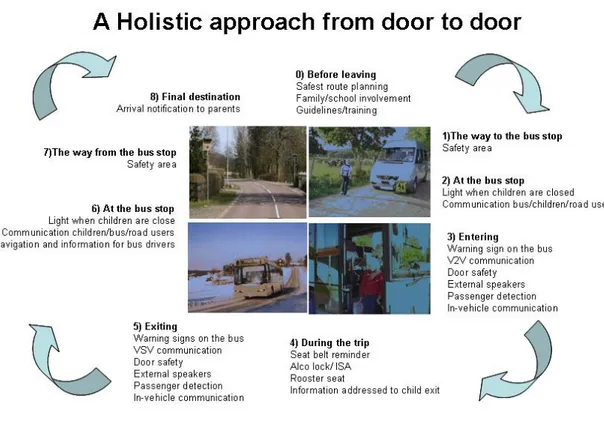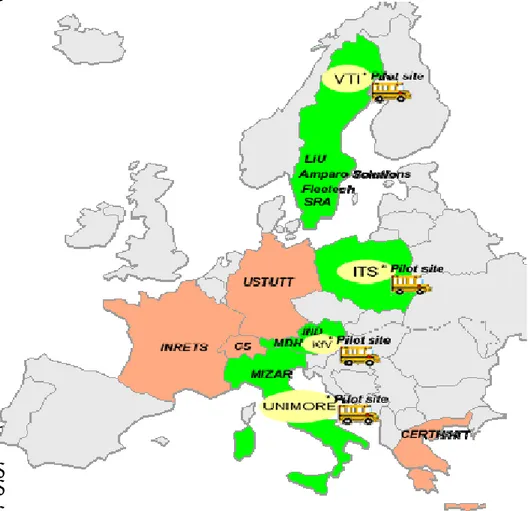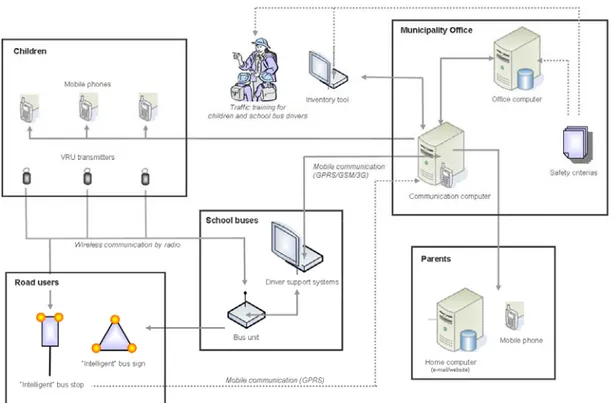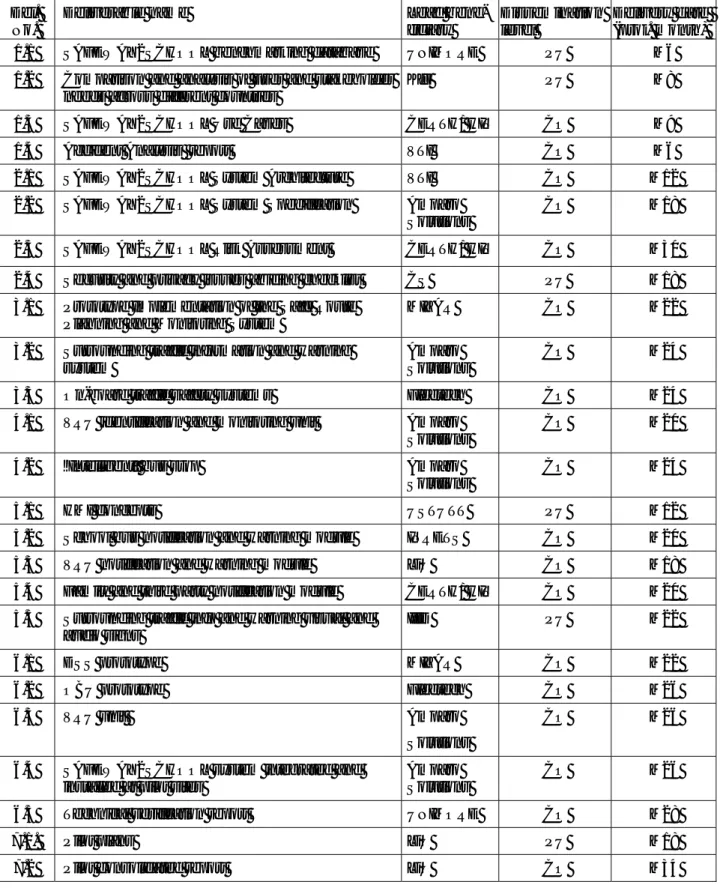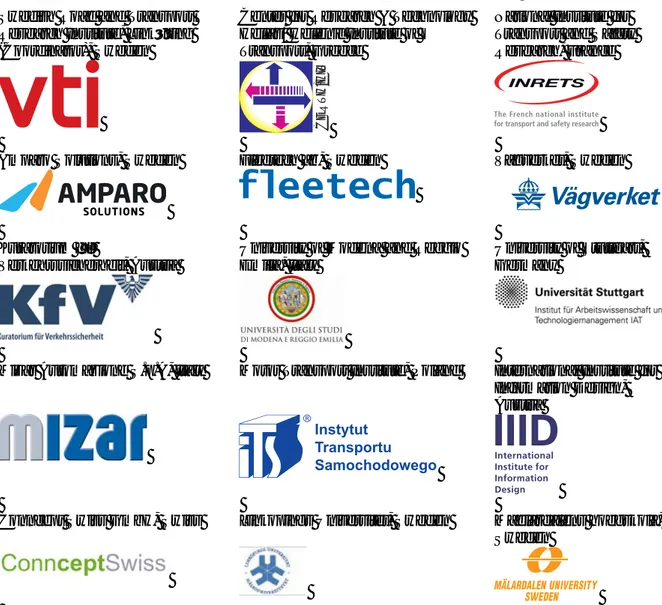SUSTAINABLE SURFACE TRANSPORT (SST)-2008-RTD-1
Integrated system for safe transportation of
children to school
SAFEWAY2SCHOOL
Grant Agreement No. 233967
Project Presentation
Deliverable No.
D10.1
Workpackage No.
WP10
Workpackage Title Project Management
Activity No.
A10.1
Activity Title
Administrative and overall
management
Authors:
Anna Anund (VTI), Tania Dukic (VTI) and Eleni
Chalkia (CERTH/HIT)
Status:
F: Final
Dissemination Level
Pu: Public
Table of contents
TABLE OF CONTENTS ... II
1.
INTRODUCTION ... 1
2.
THE CONCEPT ... 2
3.
PROJECT OBJECTIVES ... 3
4.
PILOTS AND TEST SITES ... 4
5.
DELIVERABLES ... 6
6.
CONSORTIUM ... 8
ANNEX 1: COORDINATOR AND TECHNICAL MANAGER CONTACT DETAILS 9
ANNEX 2: SHORT PROJECT DESCRIPTION ...11
Executive Summary
SAFEWAY2SCHOOL is a European research project carried out by research institutes, universities and industry in order to enhance safety for children on their daily way to school. SAFEWAY2SCHOOL aims to design, develop, integrate and evaluate technologies for providing a holistic and safe transportation service for children, from their home door to the school door and vice versa, encompassing tools, services and training for all key actors in the relevant transportation chain. These include optimal route planning and rerouting for school buses to maximize safety, on-board safety applications (i.e. for speed control and seat belts), "intelligent" bus stops, effective warning and information systems for bus drivers, children, parents and the surrounding traffic; as well as training schemes for all actors. The project innovative systems, services and training schemes will be tested in 4 sites Europewide, including North (Sweden), Central (Austria), South (Italy) and Eastern (Poland) Europe; to evaluate their usability, efficiency, user acceptance and market viability; taking into account the very different children's transportation to/from school systems across the different European regions as well as key cultural and socio-economic aspects.
1. Introduction
Between 1994 and 2001, 361 children were injured or killed during transportation to/from their school in Sweden, whereas 455 were killed or injured in Austria only in 2007 and 97 were killed in Italy in 2005. In a single school bus accident in Greece in 2003, 20 children lost their lives. Different as the above numbers may be, they all tell us one thing: crashes involving school buses and crashes involving children travelling to and from school are far from negligible and require further efforts to be drastically reduced.
2. The concept
SAFEWAY2SCHOOL is an EU-project within the 7:th Framework with a start 1/9/2009, running for 36 months. The total budget is 3,7€ millions. The aims are to design, develop, integrate and evaluate technologies for providing a holistic and safe transportation service for children, from their home door to the school door and vice versa, encompassing tools, services and training for all key actors in the relevant transportation chain. These include optimal route planning and rerouting for school buses to maximize safety, on-board safety applications (i.e. for speed control and seat belts), “intelligent” bus stops, effective warning and information systems for bus drivers, children, parents and the surrounding traffic; as well as training schemes for all actors. The project innovative systems, services and training schemes will be tested in 4 sites Europewide, including North (Sweden), Central (Austria), South (Italy) and Eastern (Poland) Europe; to evaluate their usability, efficiency, user acceptance and market viability; taking into account the very different children's transportation to/from school systems across the different European regions as well as key cultural and socio-economic aspects. The SAFEWAY2SCHOOL concept is based on a holistic approach with a door to door perspective, see Figure 1. To assure a good and safe quality of school transportation several stakeholders needs to be involved.
Figure 1 The SAFEWAY2SCHOOL approach form door to door perspective
The project follows a holistic approach from the children door to door perspective. Use cases will be defined at the beginning of the project by collecting crash data through available databases from European countries. To insure children a safe way from home to the bus stop and from bus to school, communication has to be established between children/bus stop and road users. The project’s scope include both software and hardware development. A new sign for school transport will be developed to display on buses that assure school transport. An HMI profile in relation to all situations will be developed – from support system for the bus driver to the arrival notification, training schemes and municipality’s office.
3. Project objectives
More specifically, SAFEWAY2SCHOOL aims at:
Developing optimal route planning for school buses, to guide them through areas of low traffic, avoiding black spots.
Developing optimal real-time route guidance, taking into account dynamic traffic data, as well as the arrival and estimated arrival of children at the bus stops.
Developing “intelligent” bus stops that understand the position of children and school buses and transmit relevant info and warnings to both actors.
Developing a seamless, reliable and secure system of school bus position tracking and monitoring and a parents’ notification system, when children are on-board the school bus. Integrating safety enhancement applications regarding speed monitoring and safety belt
usage for the school bus, while travelling.
Developing warning systems for surrounding vehicles on the existence of stopped school buses or/and children waiting/ entering/ exiting.
Developing appropriate training schemes for school bus drivers, children, parents and all drivers, for optimal use of the developed systems and children safety enhancement in general.
Performing socio-economic analysis, to identify the optimal business plans, legal schemes and organizational incentives for rapid adoption and wide market penetration of SAFEWAY2SCHOOL system.
Target Groups of the project include: School bus drivers.
Students/ children: 6-9, 10-12 and 13-16 years old, with and without disabilities, when they may travel alone from/to school bus, although some applications (e.g safety belt use) are for all ages.
Families of the children.
Infrastructure (i.e. bus stops or bus fleet operators). Car manufacturers (OEM’s).
Authorities (legislators, municipal and school authorities). All drivers (i.e. of surrounding traffic vehicles).
The project aims to combine a wide range of technologies on localization, route planning, route guidance, vehicle to infrastructure and on-board systems and sensors, short-range and GPRS communications, etc; in order to solve holistically the issue of safe transportation of children from their door to the school and vice-versa.
4. Pilots and test sites
The largest effort in the project will be spend to test services and training schemes in 4 sites in Europe: Sweden, Austria, Italy and Poland, see
Figure 2. Here the systems will be evaluate regarding their usability, efficiency, user acceptance and market viability; taking into account the very different children’s transportation to/from school systems across the different European regions. The pilots will utilise off-the-shelf technology, in order to create a driver support system that raises the level of routines in school transportation and facilitates communication between the drivers and the children.
Figure 2 Pilot sites with in SAFEWAY2SCHOOL, the buses represent the pilot sites and countries in colour are beneficiaries’ representation within the project.
The draft of the system architecture gives a first idea of the different systems involved and stakeholders’ interests see Figure 3.
Figure 3 Draft system architecture for SAFEWAY2SCHOOL
The project will provide guidelines for authorities and give input for training courses for children, parents, bus drivers and other relevant stakeholders. Recommendations for policy and standardisation of school transportation through European members’ countries will be delivered within the project. Moreover, a user forum and workshops will support dissemination of the project and provide us valuable feedback from stakeholders.
5. Deliverables
Within the SAFEWAY2SCHOOL project in total 42 Deliverables will be written, see Table 1, most of them Public.
Table 1 List of Deliverables within the SAFEWAY2SCHOOL
Del. No.
Deliverable name Lead
bene-ficiary
Dissemination level
Delivery date (proj. month) 1.1 SAFEWAY2SCHOOL benchmarking database UNIMORE PU M6 1.2 Comparison and analysis of user and stakeholder
needs across different countries
Kfv PU M8
1.3 SAFEWAY2SCHOOL Use Cases CERTH/ HIT CO M9
1.4 Accident Analysis report VTI CO M6
2.1 SAFEWAY2SCHOOL System Architecture VTI CO M12
2.2 SAFEWAY2SCHOOL System Specification Amparo Solutions
CO M18
2.3 SAFEWAY2SCHOOL Risk Assessment CERTH/ HIT CO M30
2.4 Security and privacy issues abiding checklist CS PU M18 3.1 Prototype Implementation of the Safe Route
Planning and Monitoring System
MIZAR CO M22
3.2 Surrounding traffic information and warning system
Amparo Solutions
CO M24
3.3 On-board traffic safety systems Fleetech CO M24
4.1 VRU identification and monitoring unit Amparo Solutions
CO M20
4.2 “Intelligent” bus stop Amparo
Solutions
CO M24
5.1 HMI concepts USTUTT PU M12
5.2 School bus notification and warning module INRETS CO M20
5.3 VRU notification and warning module LiU CO M18
5.4 Family and third party notification module CERTH/ HIT CO M20 5.5 Surrounding traffic info and warning visual and
audio signs
IIID PU M22
6.1 DSS prototype MIZAR CO M22
6.2 OBU prototype Fleetech CO M26
6.3 VRU unit Amparo
Solutions
CO M26 6.4 SAFEWAY2SCHOOL system integrated and
installed at pilot sites
Amparo Solutions
CO M26
6.5 Technical verification report UNIMORE CO M28
Del. No.
Deliverable name Lead
bene-ficiary Dissemination level Delivery date (proj. month) 8.1 Dissemination Plan CS CO M3
8.2 Project logo, leaflets, posters, web site CS PU M3
8.3 Dissemination strategy and actions CS PU M6
8.4 Project workshops CS PU M9
8.5 Market analysis Amparo
Solutions
PU M12
8.6 Project video CS PU M30
8.7 Impact assessment and socio-economic analysis CS CO M34
8.8 Exploitation plan MDH CO M36
8.9 Consolidation of Dissemination Actions CS PU M36
9.1 Training schemes and content ITS PU M30
9.2 Application guidelines and best practices Kfv PU M35 9.3 Policy and standardisation recommendations SRA PU M36
10.1 Project Presentation VTI PU M2
10.2 Project Management and Quality Assessment plan
VTI RE M3
10.3 First Periodic Management Report VTI,
CERTH/HIT
CO M20 10.4 Second Periodic Management Report VTI,
CERTH/HIT
CO M36
10.5 Final Report VTI,
CERTH/HIT
6. Consortium
Consortium for SAFEWAY2SCHOOL is composed by a combination of beneficiaries
from research institutes, universities and industry. In Table 2 the beneficiaries and
there logos are presented.
Table 2 Beneficiaries represented in the SAFEWAY2SCHOOL consortium Swedish Road and Transport
Research Institute, Linköping (Coordinator), Sweden
Center for Research & Technology Hellas/ Hellenic Institute of
Transport, Greece
National Institute for Transport and Safety Research, France
CER
TH/HIT
Amparo Solutions, Sweden Fleetech ab, Sweden Vagverket, Sweden
Kuratorium für
Verkehrssicherheit, Austria
University of Modena and Reggio Emilia, Italy
University of Stuttgart, Germany
Mizar Automazione S.p.A, Italy Motor Transport Institute, Poland International Institute for Information Design, Austria
Conncept Swiss GmbH, Swiss Linkopings Universitet, Sweden Maelardalens hoegskola, Sweden
For further questions please look at our website www.safeway2school.eu or feel free to contact: Anna Anund, Coordinator anna.anund@vti.se or Evangelos Bekiaris, Technical Manager abek@certh.gr.
Annex 1: Coordinator and Technical Manager Contact
Details
Coordinator contact details
Name
Dr. Anna Anund
Title Researcher
Organisation
Swedish Road and Transport Research Institute
Address
Olaus Magnus väg 35, 581 95 Linköping, Sweden
Telephone
+ 46 13 204327
Fax
+ 46 13 141436
E-mail anna.anund@vti.se
Technical Manager contact details
Name
Dr. Evangelos Bekiaris
Title Mechanical
Engineer,
Ph.D. Research Director (Grade A)
Organisation
Centre for Research and Technology Hellas
Hellenic Institute of Transport
Address
6
th
km, Charilaou - Thermi Road
P.O. Box 361, 17455 Thermi-Thessaloniki, Greece
Telephone
+30210 9844 560
Fax
+30 210 9853 193
abek@certh.gr
PROJECT INFORMATION
Project acronym: SAFEWAY2SCHOOL
Project name:
Integrated system for safe transportation of children to school
Grant agreement no.: 233967
Priority component: SEVENTH FRAMEWORK PROGRAMME
SUSTAINABLE SURFACE TRANSPORT (SST)-2008-RTD-1
Project Logo:
Project Web Site:
www.safeway2school.eu
List of participants:
Beneficiary Number *
Beneficiary name Beneficiary short name Country Date enter project Date exit project 1 (Coordinator) Statens väg och transportforskningsinstitut VTI Sweden M1 M36
2 Center for Research & Technology Hellas/ Hellenic Institute of Transport
CERTH/HIT Greece M1 M36
3 National Institute for Transport and Safety Research
INRETS France M1 M36
4 Amparo Solutions Amparo Solutions Sweden M1 M36
5 Fleetech ab Fleetech Sweden M1 M36
6 Vagverket SRA Sweden M1 M36
7 Kuratorium für Verkehrssicherheit KfV Austria M1 M36 8 University of Modena and Reggio Emilia UNIMORE Italy M1 M36
9 University of Stuttgart USTUTT Germany M1 M36
10 Mizar Automazione S.p.A MIZAR Italy M1 M36
11 Motor Transport Institute ITS Poland M1 M36
12 International Institute for Information Design
IIID Austria M1 M36
13 Conncept Swiss GmbH CS Swiss M1 M36
14 Linkopings Universitet LiU Sweden M1 M36
15 Maelardalens hoegskola MDH Sweden M1 M36
Total project cost: 3 668 737 Euro
II. PROJECT MAIN GOALS
SAFEWAY2SCHOOL aims to design, develop, integrate and evaluate technologies for
providing a holistic and safe transportation service for children, from their home door to the
school door and vice versa, encompassing tools, services and training for all key actors in the
relevant transportation chain.
III. KEY ISSUES
With help of a holistic approach increase safety and security for children going to and from
school by bus.
IV. TECHNICAL APPROACH
Optimal route planning and rerouting for school buses to maximize safety, on-board safety
applications (i.e. for speed control and seat belts), “intelligent” bus stops, effective warning
and information systems for bus drivers, children, parents and the surrounding traffic; as well
as training schemes for all actors.
V. EXPECTED ACHIEVEMENT / IMPACT
SAFEWAY2SCHOOL aims to increase the level of safety and security of the overall transport operation of children going / returning from school and all its components (trip to the bus stop, ingress / egress, while on-board), thus reducing the number of relevant accidents and fatalities.
SAFEWAY2SCHOOL builds automatic interfaces between the driver and the children on-board (i.e. to automatically check that they wear their seat belt), the operation and the parents / school authorities (automatically informing them that the specific child is safely on-board), the child and the driver before boarding (i.e. automatically informing the driver through the intelligent bus stop that the child is there and waiting or at a near distance, etc.). Relevant interfaces are iteratively developed and optimised within WP5 of the project, with emphasis also on human interfaces that are intuitive, user-friendly and standardised (i.e. through standardised icons and signs to inform the surrounding traffic that a bus is transporting children or that they are embarking / disembarking at this moment).
SAFEWAY2SCHOOL develops modular systems that can be used by dedicated school buses as well as generic public buses transferring children. Thus, it aims to maximise safety and security of operation, without requiring of extra vehicles or travellers in any country. The consequence will be that children and parents will feel more confident to use the bus (public or specific purchased) instead of a passenger car. The final result will be a reduction in the CO2 emissions.
VI. COORDINATOR CONTACT DETAILS
Name Dr. Anna Anund
Title Researcher
Organisation Swedish Road and Transport Research Institute Address Olaus Magnus väg 35, 581 95 Linköping, Sweden Telephone + 46 13 204327
